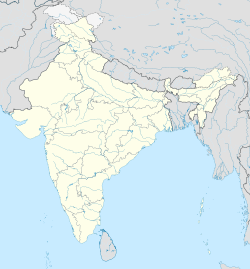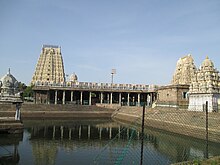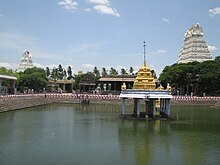Kanchipuram
| Kanchipuram காஞ்சிபுரம |
||
|---|---|---|
|
|
||
| State : |
|
|
| State : | Tamil Nadu | |
| District : | Kanchipuram | |
| Sub-district : | Kanchipuram | |
| Location : | 12 ° 50 ′ N , 79 ° 42 ′ E | |
| Height : | 88 m | |
| Area : | 36.14 km² | |
| Residents : | 164,384 (2011) | |
| Population density : | 4549 inhabitants / km² | |
| Website : | [1] | |
Kanchipuram ( Tamil : காஞ்சிபுரம Kāñcipuram [ ˈkaːɲd͡ʒipurʌm ]; short form Kanchi, more rarely Kancheepuram, formerly also Anglicised Conjeevaram ) is a city in the southern Indian state of Tamil Nadu with around 165,000 inhabitants. Kanchipuram is one of the oldest cities in South India and is one of the seven holy places of Hinduism ; it is an important pilgrimage site where Shiva and Vishnu are equally venerated.
geography

Kanchipuram lies at an altitude of almost 90 m above sea level. d. M. in the hinterland of the Coromandel Coast in northern Tamil Nadu around 75 km (driving distance) southwest of Chennai . The city is the capital of the Kanchipuram district . The periodically water-bearing Palar River runs around four kilometers south of Kanchipuram . The smaller river Vegavathi flows through the city itself . The climate in Kanchipuram is tropical and warm; Rain falls almost only in the monsoon months from July to December.
The municipality ( municipality ) Kanchipuram has an area of 36 square kilometers. Kanchipuram is commonly divided into two areas, which are named after the deity that predominates there. Shiva Kanchi or Periya Kanchi ("big Kanchi") comprises the northwestern part of Kanchipuram. The Ekambaranatha Temple, dedicated to Lord Shiva , and the Kamakshi Temple are located here . The southeastern part Kanchipurams with the god Vishnu consecrated Varadaraja Perumal Temple is a Vishnu Kanchi or Chinna Kanchi known ( "little Kanchi"). Originally, this area was an independent village called Attiyur; meanwhile it has grown together with Kanchipuram. In addition to these two parts of the city, Jina Kanchi is also known, the Jainist area around the village of Thiruparuthikundram on the southwestern edge of Kanchipuram.
history
Kanchipuram already existed in pre-Christian times. In Ptolemy is as the name Malanga called. In the 3rd century AD , the Pallava dynasty from Andhra Pradesh extended their sphere of influence to the city and soon after made it their capital. The Pallava teamed up as a promoter of Hinduism forth, yet Kanchipuram was also an important center of Mahayana - Buddhism and Jainism . The Chinese monk Xuanzang , who visited Kanchipuram in the 7th century, reported about 80 Hindu temples in the city and a large Buddhist monastery in the area. Several temples from the 7th and 8th centuries still bear witness to the city's heyday. In addition, the university , which existed in the first centuries AD, was considered an important place of Sanskrit and Tamil scholarship.
After the conquest by the Chola in the 9th century, Kanchipuram lost its role as the seat of the ruler, but it remained an important religious center. From the 13th century onwards, the city experienced changing rulers: the Chola was followed by the Pandya , the Chalukya of Badami and the Vijayanagar Empire . After the Carnatic Wars (1744–1763) Kanchipuram came under the influence of the British East India Company .
population
The increase in the population in recent decades is mainly due to the continued immigration of families from the surrounding area.
| year | 1991 | 2001 | 2011 |
| Residents | 144.955 | 153.140 | 164.384 |
A good 93 percent of the residents of Kanchipuram are Hindus , a good 5 percent are Muslims and just under 1 percent are Christians ; Jainas make up less than half a percent of the population. As in all of Tamil Nadu, the main language is Tamil , which is spoken by 85 percent of the population as their mother tongue. Almost 7 percent speak Telugu , around 3 percent Urdu and 2.5 percent Saurashtri .
economy
The most important line of business in the city is the manufacture of silk saris , mostly on hand looms. Most silk weavers are organized in cooperatives . Tourism is becoming increasingly important.
Religious meaning
Kanchipuram is a Hindu pilgrimage center of supraregional importance. A well-known Sanskrit verse lists Mathura , Dwarka , Ayodhya , Haridwar , Kanchipuram, Ujjain and Varanasi as the "seven cities" ( saptapuri ) whose visit promises a pilgrim liberation ( moksha ) from the cycle of rebirths. In Kanchipuram, all three main currents of Hinduism - Shaivism , Shaktism and Vishnuism - are represented. With the Shankaracharya of Kanchipuram, the city is also the seat of an important monastic institution.
Also of Buddhism and Jainism had in Kanchipuram in earlier times a strong presence. According to the Chinese pilgrim monk Xuanzang (Hsüan-tsang), who visited Kanchipuram in the 7th century, there are said to have been more than 100 Buddhist monasteries with 10,000 monks in Kanchipuram. Today Buddhism has completely disappeared from South India. Only a few orphaned Buddha statues that have been found in various parts of the city are reminiscent of the Buddhist history of Kanchipuram . Jainism continues as a minority religion, but has lost much of its importance. In Thiruparuthikundram or Jina Kanchi, a village once inhabited by Jainas on the southwestern edge of Kanchipuram, there are still two Jain temples, but most of the Jain families have moved away.
Attractions
Kanchipuram is also known as the "City of a Thousand Temples ". In fact, around 200 Hindu temples are still preserved, several of which have their origins in the heyday of the Pallava (7th and 8th centuries), but which were rebuilt or renewed during the rule of the Cholas or the Vijayanagar empire. The three largest temples of Kanchipuram, the Ekambaranatha Temple, the Kamakshi Temple and the Varadaraja Perumal Temple, each represent one of the three Hindu currents that are present in Kanchipuram (Shaivism, Shaktism and Vishnuism). While these temples are especially important from a religious point of view and attract numerous pilgrims, other temples focus on the importance of art history. This is especially true of the Kailasanatha and Vaikuntha Perumal temples, which are among the masterpieces of Pallava architecture. Besides Hindu pilgrims, Kanchipuram is also visited to a lesser extent by foreign tourists, often as part of a day trip from Chennai or Mamallapuram .
Ekambaranatha Temple
The Ekambaranatha Temple (also Ekambarenvara Temple) is the largest temple in Kanchipuram. He is consecrated to the god Shiva in his form as the "lord of the one mango tree" ( Ekambaranatha ). The oldest parts of the temple go back to the Pallava period, but it has been rebuilt and expanded over the centuries. Today the Ekambaranatha Temple is a spacious complex with an area of 9.5 hectares. Five concentric areas ( prakara ) with numerous side shrines, corridors, pillared halls and two temple ponds are grouped around the main shrine . The main focus of worship is next to the linga in the main shrine and a sacred mango tree in the courtyard of the third prakara . The main entrance on the south side of the temple complex is crowned by a 59 meter high gate tower ( gopuram ), which is one of the highest in South India. It was built in the early 16th century during the Vijayanagar period.
Kamakshi temple
The Kamakshi Temple is dedicated to the goddess Kamakshi . It is one of the most important centers of goddess worship in South India. It may have originally been a Buddhist shrine that was later rededicated as a Hindu temple. Today the Kamakshi Temple is closely related to the Shankaracharya Monastery. Legend has it that Shankara , the founder of this tradition, tamed the once wild goddess Kamakshi with a mystical diagram ( yantra ). The Kamakshi Temple is located in the center of Kanchipuram. The approximately rectangular temple complex has a gate tower ( gopuram ) on each of its four sides. Inside the complex there is a large temple pond, several side shrines and the inner area with the actual sanctuary of the Kamakshi. The center of the temple is the Holy of Holies ( Garbhagriha ), above which a gilded tower ( Vimana ) rises.
Varadaraja Perumal Temple
The Varadaraja Perumal Temple is dedicated to the god Vishnu under the name Varadaraja Perumal. It is the most important Vishnu temple in Kanchipuram and next to the temple of Srirangam the most important Vishnuit shrine in Tamil Nadu. The Varadaraja Perumal Temple is located in the Vishnu-Kanchi district in the east of the city. The extensive temple complex has a large gate tower ( gopuram ) in the east and west. The interior of the temple is divided into three concentric areas ( prakaras ) with a temple pond, numerous side shrines and pillared halls and the main sanctuary in the center.
Kailasanatha Temple
The oldest of all the surviving temples, the Kailasanatha temple in honor of Shiva, consisting mainly of sandstone , was built around 700 using the principles developed in Mamallapuram. To date it has hardly undergone any structural changes and is therefore considered to be one of the most outstanding examples of early Hindu temple architecture in the South Indian Dravida style , to which the Chola should still refer in their buildings 300 years later. There are even wall paintings from the time of its creation. Around the central sanctuary ( Garbhagriha ), which is open to the east and overlooked by a four-storey temple tower ( Vimana ), seven smaller shrines are arranged, which are also crowned by small towers. To the east is an originally free-standing vestibule ( mandapa ), which was probably only connected to the actual temple by another hall in the 14th century. Numerous small cells with vimanas are embedded in the rectangular surrounding wall of the temple complex . A tower rises above the eastern entrance gate, which already shows features of the later, splendidly designed gate towers ( gopurams ) of South India.
Vaikuntha Perumal Temple
The Vaikuntha Perumal Temple , built in the late 8th century, is the second important Pallava temple in Kanchipuram after the Kailasanatha Temple. It is consecrated to Vishnu , who is represented as a sculpture standing, sitting or lying in the three superimposed rooms of the cella . The porticos of the vestibule decorated with lions are particularly artistic. Reliefs along the boundary wall of the temple possibly tell the story of the Pallava dynasty.
sons and daughters of the town
- CN Annadurai (1909–1969), politician and author for stage and film
- DK Pattammal (1919–2009), singer of South Indian classical music
- CS Seshadri (1932-2020), mathematician
Web links
- Kanchipuram, sights - photos + information (English)
- Kanchipuram, Temple - Video, Part 1 (English)
- Kanchipuram, Temple - Video, Part 2 (English)
Individual evidence
- ↑ Kanchipuram - Map with altitude information
- ↑ Kanchipuram - climate tables
- ↑ Kanchipuram City Website: About City.
- ↑ Kerstin Schier: The Goddess's Embrace. Multifaceted Relations at the Ekāmranātha Temple Festival in Kanchipuram, Wiesbaden: Harrassowitz, 2018, pp. 15-17.
- ↑ Ptolemy 7.1.92
- ↑ Kanchipuram - Census 1991–2011
- ^ Census of India 2011: C-1 Population By Religious Community. Tamil Nadu.
- ↑ Census of India 2011: C-16 Population By Mother Tongue - Town Level. Tamil Nadu.
- ^ Anne Feldhaus: Connected Places. Region, Pilgrimage, and Geographical Imagination in India, New York: Palgrave Macmillan, 2003, p. 128.
- ↑ CR Srinivasan: Kanchipuram Through the Ages, Delhi: Agam Kala Prakashan, 1979, pp. 231-238.
- ↑ Mahima A. Jain: "Looking for Jina Kanchi", in: The Hindu, February 1, 2016.
- ↑ Schier 2018, pp. 17–38.
- ^ D. Denis Hudson: The Body of God. An Emperor's Palace for Krishna in Eighth-Century Kanchipuram, New York: Oxford University Press, 2008.







